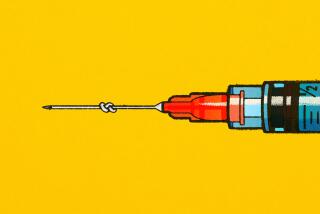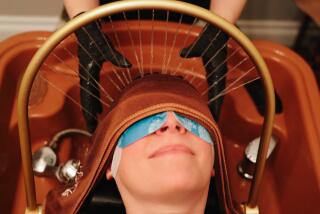Hair Clinics Find Thin Is Profitable
- Share via
Life in Toronto was pleasant, but William Edwards thought he’d really thrive in a city with a lot more smog and a lot more stress.
“They make problems occur much faster,” said Edwards, a Canadian biochemist. “Los Angeles was the perfect place to go.”
For the record:
12:00 a.m. Feb. 21, 1991 For the Record
Los Angeles Times Thursday February 21, 1991 Valley Edition View Part E Page 7B Column 1 Zones Desk 2 inches; 61 words Type of Material: Correction
Hair products--In a story on the An-Tech Research Labs, it was reported that two firms with hair growth products were ordered by the Federal Trade Commission to pay refunds to customers who had suffered monetary injury. In November, 1990, a U.S. District Court ruled that the FTC had not proved that a hair product advertised by the Pantron Corp. of Los Angeles was “wholly ineffective.” The court threw out the order to reimburse customers.
Edwards had good reason for seeking out two elements most Southern Californians try to get away from. As president of An-Tech Research Labs, a Canadian-owned company that analyzes and provides treatment for thinning hair and scalp problems, Edwards’ goal was to set up offices where people would need them most.
“All kinds of things can affect your hair, from an emotional trauma like death or divorce, to an illness, to going on a diet, to coloring it,” he said. “Micropollutants and residues from shampoos often end up being the biggest problems for a lot of people, including a lot more women. Over time, those pollutants work their way down and build up beneath the scalp.”
Add to that a fast-paced lifestyle and stress, he said, and eventually the hair follicle weakens “and the hair shaft simply falls out.”
Unlike commercial hair products designed to cleanse and condition hair, An-Tech claims to have developed “scientifically formulated bio-stimulant treatments” that penetrate the scalp and cleanse the hair follicle of impacted micropollutants and sebum, a naturally produced oil. After analysis of their hair under a high-powered microscope that shows the enlarged hair shaft on a computer screen, most clients are advised to begin receiving scalp treatments three times a week.
Many dermatologists, however, are skeptical of An-Tech’s ability to prevent hair loss and question any product--other than the scientifically proven compound Minoxodil--that claims success at growing new hair. Nevertheless, the company appears to have found a receptive market.
In 1984, An-Tech opened an office in the Cedars-Sinai Medical Tower in Los Angeles. Two years later, it established another one in Encino, and two more locations in Long Beach and downtown Los Angeles soon followed. Edwards claims to receive a positive response from “99% of clients,” who range from film stars and rock musicians to teachers and construction workers, according to written testimonials in the An-Tech office.
On first impression, the company’s offices resemble a doctor’s office. Clients browse through magazines in modern waiting rooms until they are led by white-coated attendants to one of the numerous treatment cubicles inside. There, scalps are massaged with the treatment solution, then wrapped in heat packs for about 20 minutes.
Alexander Leibman, director of An-Tech’s Encino office, adds to the clinical atmosphere by wearing a white doctor’s coat as he moves from head to head, checking each client’s progress.
“At salons, they are interested only in the cosmetic treatment of the hair,” said Leibman, a Russian-born physician who gave up practicing medicine when he emigrated to the United States in 1977. “But in the same way that a person with cancer can look healthy, hair that is unhealthy also doesn’t always look it. What we do here is remove the buildup that leads to hair loss so that new hair is measurably stronger, thicker and healthier.”
The cost of trying to grow healthier hair, however, doesn’t come cheaply. Although the initial hair analysis is free, regular in-office applications and the products clients take home cost about $250 a month. Several clients said they had spent thousands of dollars over the course of a year.
“Basically, my attitude is that I’d rather spend the money now, even though I’m not a millionaire, than wait until I have the money but don’t have any hair left,” said Al Friedman, a 24-year-old security company employee who had “tried everything,” including Minoxodil, before beginning treatments six months ago.
Numerous other clients, interviewed at the company’s Encino and Los Angeles offices, expressed satisfaction with results.
One 27-year-old teacher from Burbank told how panicked she felt when she began losing “handfuls” of hair and the helplessness she experienced when her dermatologist told her it was a normal part of getting older.
“People used to tell me that my hair was so beautiful I should be on a shampoo commercial, but then it all started falling out,” said the woman, who still had thick, below-the-shoulder hair. “I haven’t been coming here that long, but at least I haven’t lost any more hair. So whatever I have to pay is worth it.”
But it is that attitude of desperation, dermatologists say, that leads many people to what often end up being worthless promises of hair restoration. Several companies in recent years--including the Pantron Corp. of Los Angeles and California Pacific Research--have come under fire for falsely claiming in television commercials that their products curtailed hair loss and promoted new hair growth. In 1989, the Federal Trade Commission sought injunctions against both firms and ordered them to pay refunds to customers who had suffered monetary injury.
“We’ve seen all of this stuff before,’ said Dr. Jeff Ashley, a Burbank dermatologist. “There are all kinds of fly-by-night organizations that just prey on people who are losing their hair.”
Several dermatologists said that, although some cases of hair loss can be traced to medical problems, many people who simply “wait out” a period of hair loss will see improvement, even if they do nothing.
Normal hair loss, according to physicians, ranges from 30 to 100 hairs a day. Some people may believe that the hair loss they are experiencing is abnormal, they add, when it really isn’t.
“I’ve had clients with a few hairs coming out tell me it’s coming out in clumps,” said Dr. Gerald Steinberg, director of the Encino Dermatologic Surgical and Medical Group. “It’s also normal for hair not to be as thick as it was in a person’s teens.”
Can a product penetrate the scalp and cleanse the base of the hair follicle? Steinberg said it is possible that An-Tech’s products may be of some benefit, if that is the goal. But to date, he said, “there has been no indication that the accumulation of dead cells around the hair root has any influence on hair growth or the rate of hair loss.” Until the company produces a scientific study to back its claims--versus the unscientific stack of testimonials Leibman keeps in his desk drawer--Steinberg said he remains skeptical.
“You also have to look at the issue of suggestibility with anything like this,” he said. “For example, there have been objective studies done in the treatment of warts. Using a placebo and just suggesting that the wart will go away makes it disappear 50% of the time.”
Cognizant of the difficulties it could encounter if it made claims it couldn’t deliver, An-Tech is careful in its promises. Leibman said all clients are informed that, once a hair follicle has become so impacted that hair loss has occurred, it is like an oil well that has run dry and nothing can then be done to restore the hair shaft again. As a result, he added, men who are already bald are turned away.
“They never made any promises to me, and they told me that the hair I’d already lost couldn’t be grown again,” said Melanie Green of Los Angeles. “They did tell me that the hair I still had would grow thicker and healthier, and they’ve kept their promise about it.”
Many other clients shared that view. No matter what any dermatologist said to the contrary, several customers said, they would continue the treatments. They had too many positive results, they said, to believe otherwise.
“If someone wanted to spend the same amount of money on clothes, no one would say a thing about it. But because it has to do with hair, there’s all this skepticism about it,” Friedman said.
“I tried mail-order remedies, I went to dermatologists and I even tried” Minoxodil, “but nothing worked. This is the first thing I’ve found that has.”






